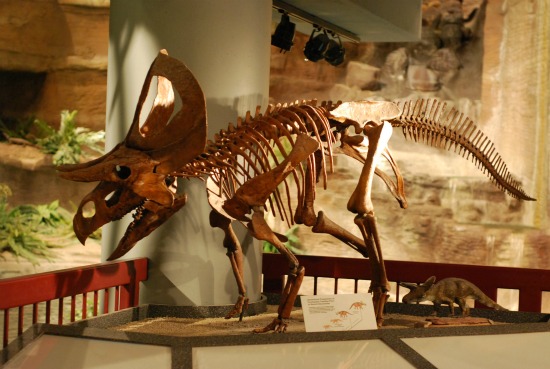
On Sunday, I drove two and a half hours to meet a dinosaur. My journey was part of a trend this year. As I have traveled around the west, from Montana to New Mexico, I have sought out dinosaurs that I have never seen before, and while at this year’s National Association of Science Writers conference in Flagstaff, I found out that the Arizona Museum of Natural History in Mesa has a mount of a unique horned dinosaur called Zuniceratops. That was all I needed to know before getting on the southbound highway.
Though unfamiliar, Zuniceratops is not a brand new dinosaur. The creature was initially described by paleontologists Douglas Wolfe and Jim Kirkland in 1998, and even got a few minutes of relative fame in 2001′s When Dinosaurs Roamed America. Not too shabby for a relative newcomer, but what horned dinosaur can compete with the celebrity of Triceratops and ridiculously well-ornamented genera such as Styracosaurus? Zuniceratops was relatively small, had only two brow horns, and doesn’t look quite as imposing as its later Cretaceous relatives, but those characteristics are part of why this dinosaur is significant to paleontologists looking at the big picture of horned dinosaur evolution.
The bones of Zuniceratops were found in the roughly 89-million to 93-million-year-old rock of western New Mexico’s Zuni Basin. This makes the dinosaur one of the oldest known ceratopsians found in North America, and, as described by Wolfe and Kirkland, the remains of Zuniceratopsexhibit a mosaic of features shared with both earlier ceratopsians (such as Protoceratops) and the later, more familiar ceratopsids (such as Triceratops). While the body of Zuniceratops appeared to retain a more archaic, lightly built form, the prominent brow horns, the arrangement of the teeth (set up like a pair of scissors to shear vertically through food), a curved part of the hip called the ischium, and other characteristics underlined a close relationship to the ceratopsid dinosaurs that would eventually become so common on the continent.
But Zuniceratops was not a “missing link” or an ancestor to any of the ceratopsid dinosaurs. Instead, it is a peculiar dinosaur with a suite of features that may help us understand the transition between the more archaic ceratopsians and the early ceratopsids. The arrangement of anatomical characters in Zuniceratops gives us a general picture of what was happening among the horned dinosaurs at the time. After all, the grand pattern of evolution is a wildly branching tree of life, and in technical terms, Zuniceratops falls on a branch just outside the ceratopsid group—a relatively close cousin—but it did not share some of the telltale characteristics of the famous dinosaur group. Hopefully, as more dinosaurs like Zuniceratops are found, paleontologists will gain a clearer picture of how the greatest of the horned dinosaurs evolved.

No comments:
Post a Comment